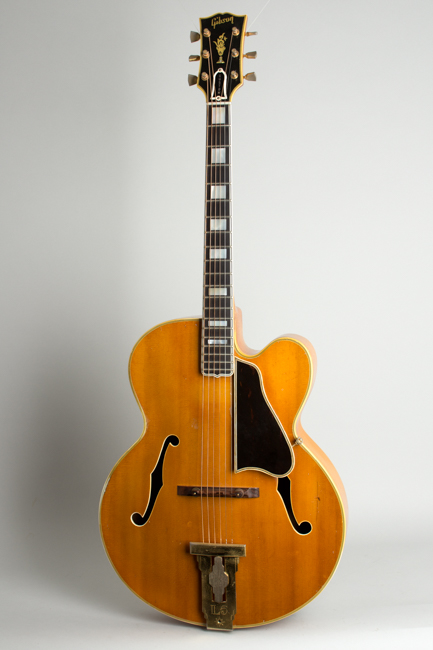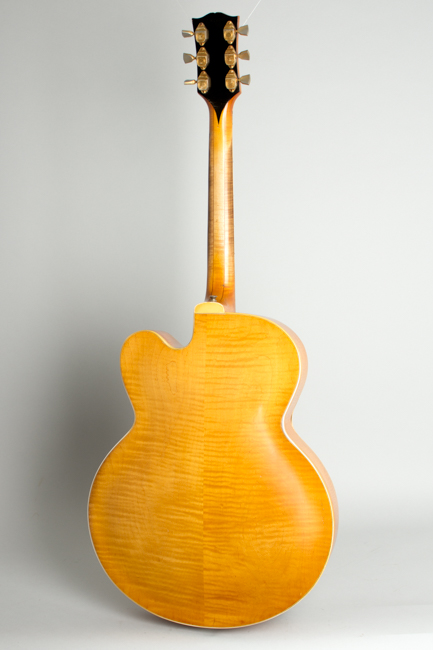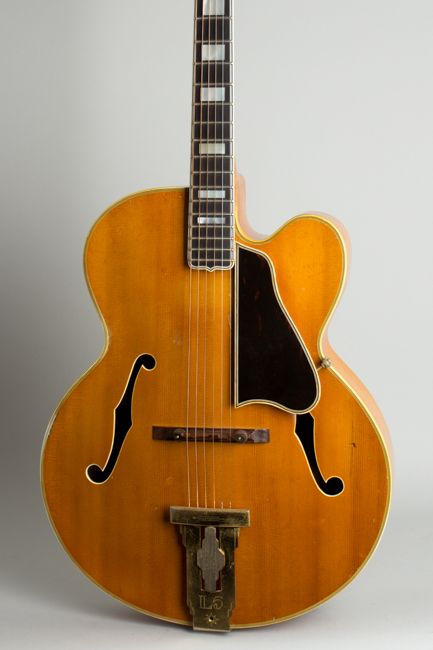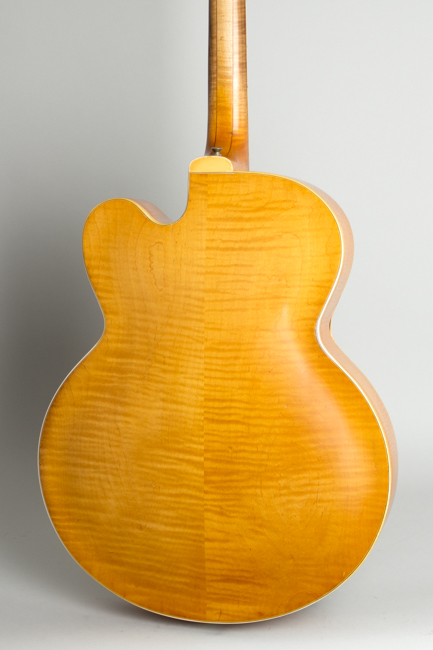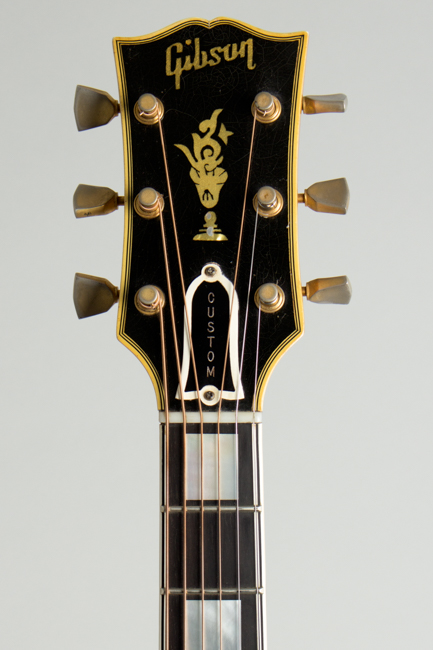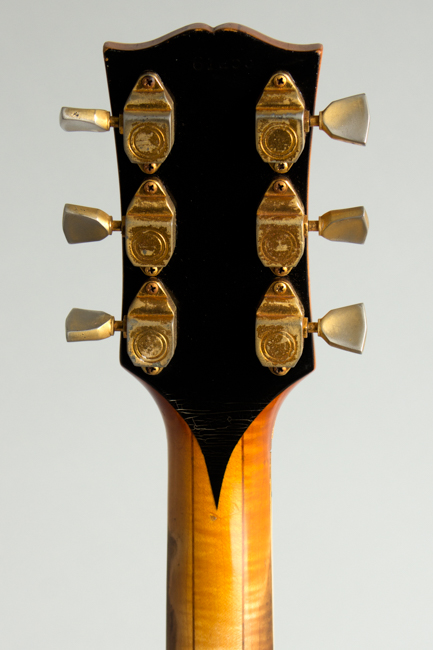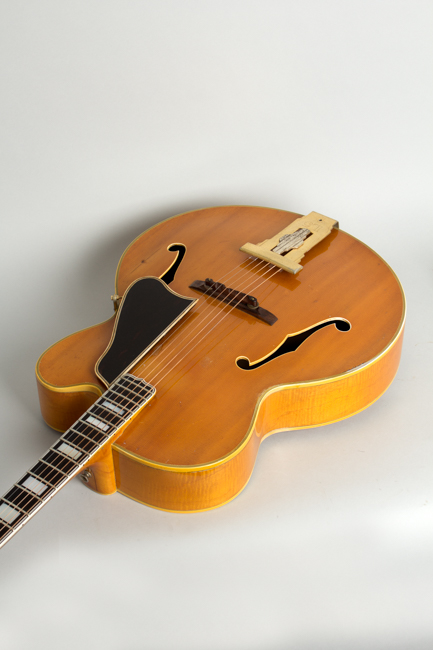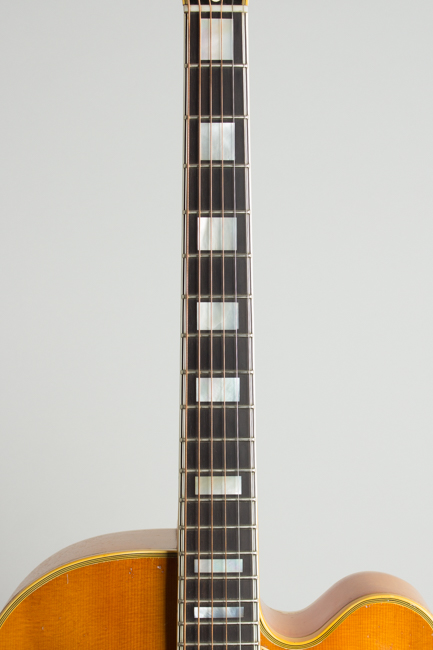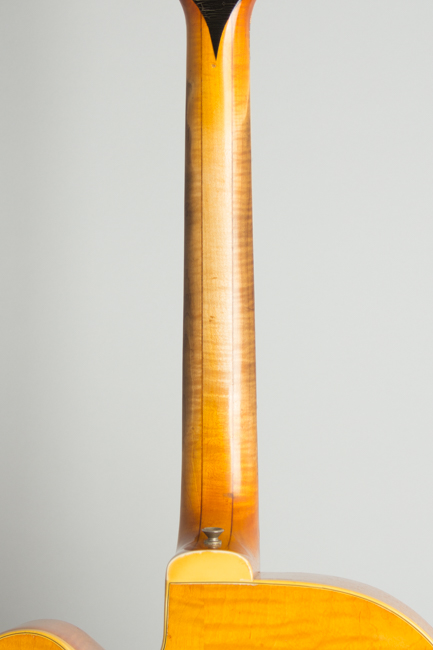Gibson L-5CN Arch Top Acoustic Guitar (1962)
This item has been sold.
Item # 9141
Prices subject to change without notice.
Gibson L-5CN Model Arch Top Acoustic Guitar (1962), made in Kalamazoo, Michigan, serial # 61253, natural lacquer finish, maple body and neck, spruce top, ebony fingerboard, original brown tolex hard shell case.
This instrument is a lovely if well-played early 1960s L-5C, a guitar built in ever-decreasing numbers in the 1960s but still the epitome of Gibson's heritage. By this time full-body carved-top like this guitars were ordered only occasionally; all of 12 natural-finish L-5CN models left the factory in 1962, down to 4 the next year. In the early 1960s even most dedicated jazz and session players were buying fully electric archtops, and new construction of purely acoustic carved-top instruments was tapering off.
This guitar carries a "Custom" truss rod cover, although it appears to not have any non-stock features we can see. The beautifully grained spruce top and flame maple back are still hand-carved, as they had been since the 1910s. The traditional multiple W/B/W celluloid bindings are on every edge, and the headstock bears the L-5 "flowerpot" inlay that has always marked this model. The adjustable rosewood bridge, engraved gold-and-silver L-5 tailpiece, and gold Kluson Sealfast tuners are other trademark features. The finish is a beautifully ambered natural lacquer.
The neck profile on this guitar is the very flat, thin, back-to-front "D" common to other Gibsons of this period, but rarely encountered on a purely acoustic L-5. The neck construction is the then-recently introduced 5-way maple-ebony laminate, in place of the older 3-piece style. By 1962 a player desiring a top-grade archtop acoustic guitar had only two remaining choices: Gibson or John D'Angelico in New York. This L-5CN is an ample demonstration of the level of craftsmanship Gibson's old-like workers still brought to their traditional showpiece acoustic instruments, even in an era when electrics were the main focus. This is a superbly classy guitar, a delight to play and hear.
Overall length is 41 7/8 in. (106.4 cm.), 17 in. (43.2 cm.) wide at lower bout, and 3 3/8 in. (8.6 cm.) in depth, measured at side of rim. Scale length is 25 1/2 in. (648 mm.). Width of nut is 1 11/16 in. (43 mm.).
This old L-5 has a beautiful worn-in and "smoked" patina, and was definitely someone's gigging instrument for some time. The top finish shows numerous small dings and dents, with a larger case lid ding into the wood by the treble side f-hole.
There was a spruce grain crack running through this that has been sealed and lightly touched up, with a second similar grain split just below it treated in a similar manner. The guitar shows no other visible cracks. The top binding in the bass side waist area has shrunk up a bit, and the gap has been filled solidly but not as cleanly as we might prefer.
The top finish has an isolated spot of pick wear just above the strings, and one odd patch of missing finish just by the top edge of the pickguard. This was likely due to reaction from the cabling to some sort of pickup mounting -- there a couple of small pinholes on the side of the fingerboard extension attesting to some sort of electrification in the past. The gold plated parts show a decent amount of loss, as would be expected. There is wear to the back of the neck on both sides from play, and the guitar has been very nicely refretted not too long ago, so the frets show virtually no wear. The pickguard is a very accurate repro using the original bracket.
Other than this, the instrument remains all original except for a strap button added to the neck heel. This L-5 plays wonderfully, with a well-rounded but still crisp sound and is a great example of the final generation of these really high-grade carved guitars from Kalamazoo. It is still housed in the original brown 1950s-style case, quite well-worn but still functional. Overall Excellent - Condition.
This instrument is a lovely if well-played early 1960s L-5C, a guitar built in ever-decreasing numbers in the 1960s but still the epitome of Gibson's heritage. By this time full-body carved-top like this guitars were ordered only occasionally; all of 12 natural-finish L-5CN models left the factory in 1962, down to 4 the next year. In the early 1960s even most dedicated jazz and session players were buying fully electric archtops, and new construction of purely acoustic carved-top instruments was tapering off.
This guitar carries a "Custom" truss rod cover, although it appears to not have any non-stock features we can see. The beautifully grained spruce top and flame maple back are still hand-carved, as they had been since the 1910s. The traditional multiple W/B/W celluloid bindings are on every edge, and the headstock bears the L-5 "flowerpot" inlay that has always marked this model. The adjustable rosewood bridge, engraved gold-and-silver L-5 tailpiece, and gold Kluson Sealfast tuners are other trademark features. The finish is a beautifully ambered natural lacquer.
The neck profile on this guitar is the very flat, thin, back-to-front "D" common to other Gibsons of this period, but rarely encountered on a purely acoustic L-5. The neck construction is the then-recently introduced 5-way maple-ebony laminate, in place of the older 3-piece style. By 1962 a player desiring a top-grade archtop acoustic guitar had only two remaining choices: Gibson or John D'Angelico in New York. This L-5CN is an ample demonstration of the level of craftsmanship Gibson's old-like workers still brought to their traditional showpiece acoustic instruments, even in an era when electrics were the main focus. This is a superbly classy guitar, a delight to play and hear.
Overall length is 41 7/8 in. (106.4 cm.), 17 in. (43.2 cm.) wide at lower bout, and 3 3/8 in. (8.6 cm.) in depth, measured at side of rim. Scale length is 25 1/2 in. (648 mm.). Width of nut is 1 11/16 in. (43 mm.).
This old L-5 has a beautiful worn-in and "smoked" patina, and was definitely someone's gigging instrument for some time. The top finish shows numerous small dings and dents, with a larger case lid ding into the wood by the treble side f-hole.
There was a spruce grain crack running through this that has been sealed and lightly touched up, with a second similar grain split just below it treated in a similar manner. The guitar shows no other visible cracks. The top binding in the bass side waist area has shrunk up a bit, and the gap has been filled solidly but not as cleanly as we might prefer.
The top finish has an isolated spot of pick wear just above the strings, and one odd patch of missing finish just by the top edge of the pickguard. This was likely due to reaction from the cabling to some sort of pickup mounting -- there a couple of small pinholes on the side of the fingerboard extension attesting to some sort of electrification in the past. The gold plated parts show a decent amount of loss, as would be expected. There is wear to the back of the neck on both sides from play, and the guitar has been very nicely refretted not too long ago, so the frets show virtually no wear. The pickguard is a very accurate repro using the original bracket.
Other than this, the instrument remains all original except for a strap button added to the neck heel. This L-5 plays wonderfully, with a well-rounded but still crisp sound and is a great example of the final generation of these really high-grade carved guitars from Kalamazoo. It is still housed in the original brown 1950s-style case, quite well-worn but still functional. Overall Excellent - Condition.
